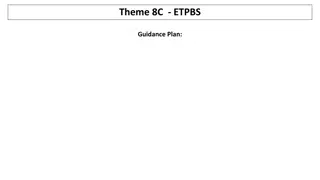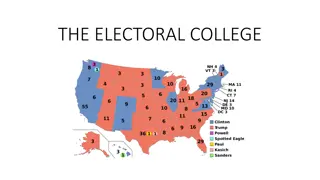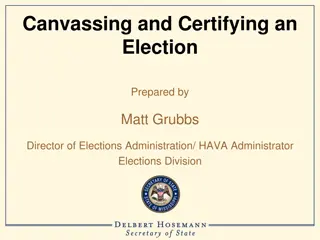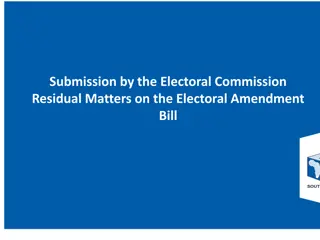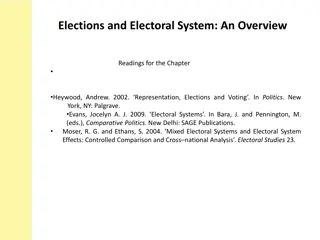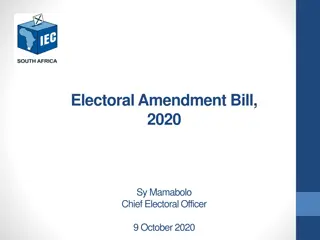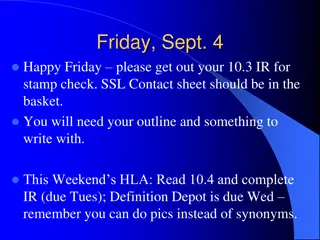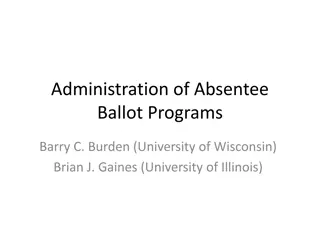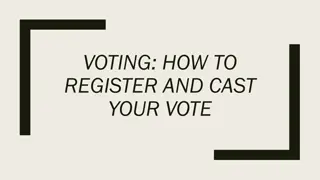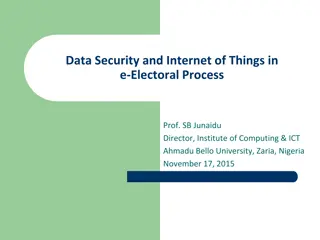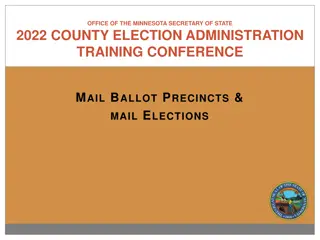Electoral Ballot Pre-Counting Procedures
Learn the detailed steps involved in the pre-counting process of electoral ballots, including scanning forms, verifying documents, and handling discrepancies using QR code technology. Follow along to ensure accurate counting and validation of service voter documents. Get insights into the systematic approach followed by election officials for efficient processing of postal ballot papers.
Download Presentation

Please find below an Image/Link to download the presentation.
The content on the website is provided AS IS for your information and personal use only. It may not be sold, licensed, or shared on other websites without obtaining consent from the author.If you encounter any issues during the download, it is possible that the publisher has removed the file from their server.
You are allowed to download the files provided on this website for personal or commercial use, subject to the condition that they are used lawfully. All files are the property of their respective owners.
The content on the website is provided AS IS for your information and personal use only. It may not be sold, licensed, or shared on other websites without obtaining consent from the author.
E N D
Presentation Transcript
ETPBS Pre-Counting Steps Step 1: The Outer covers (Form 13-C) which is having QR Code on lower right hand side, it will be read by the QR Code Reader and necessary valid checks will be performed for possible duplicates and verification of the service voter. A unique serial number will be provided by the computer. This serial number will also be manually marked by RO on the envelope being verified. Step 2: If no duplicate and correct verification is found, then only outer envelope (Form 13-C) will be open. Step 3: Open the outer cover (Form 13-C) and take out the two documents which are required to be found inside. The first one is declaration (Form 13-A) and the second one is inner cover (Form 13-B) containing the postal ballot paper. Step 4: RO should take out the declaration from Outer Envelope, Form 13-A and the inner cover in Form 13-B.
ETPBS Pre-Counting Steps cont. Step 5: Now scan two QR Codes on Form 13-A one by one and after that scan the QR Code which is on lower right side on Form 13-B. Step 6: Note down the Sl. No. generated in all the above Covers respectively. Step 7: If the QR Code reading does not raise any anomaly, keep Form 13-B envelope and Declaration back in Form 13-C envelope and keep the envelope in a tray meant for valid envelopes to be taken up for counting. If the QR Code reading indicates any discrepancy such as the documents not being genuine or multiple copies of the document have been received, such envelopes shall be kept in a separate tray meant for rejected envelopes. In case of rejection of envelopes/documents on QR Code reading, the ARO in-charge of the team should see and satisfy himself about the discrepancy shown in QR Code reading that results in rejection.
Electronically Transmitted Postal Ballot System Pre Counting Scan Form 13-C (Outer Envelope) Pre-Counting Scan Scan Form 13-A Form 13-B (Declaration) (Inner Envelope)
Scan: Form13-C & then immediately Scan Form-13-B (Leaving the Scanning Form 13-A)
Scan: Form13-C, Scan: Form 13-A & then by mistake Scan Form-13-C instead of Form 13- B again
Scan: Form13-C, Scan: Form 13-A & Scan: Form 13-B & then by mistake Scan Form-13-C, just Scanned
Scan: Form13-C & then Form-13-A Does not Exist (Manual Invalidation)
Scan: Form13-C, Scan Form 13-A & then Form-13-B Does not Exist (Manual Invalidation)
Add Elector Manually: Form 13-C (in case QR Code in not Scanned)
Add Elector Manually: Form 13-C (in case QR Code in not Scanned)
Add Elector & e-PBID Manually: Form 13-A (in case QR Code in not Scanned)
Add e-PBID Manually: Form 13-B (in case QR Code in not Scanned)
Thank You Thank You



